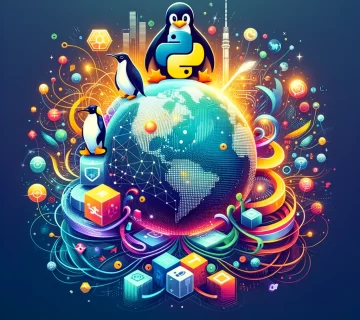Programming languages are the backbone of the technology that surrounds us, shaping the way we interact with devices, the internet, and even each other. From the analytical engines of the 19th century to the sophisticated systems powering today’s AI, the evolution of programming languages has been a journey of innovation, trial, and transformation. This post delves into the history and evolution of programming languages, highlighting key milestones and how each generation has influenced technological development.
The Genesis: Machine and Assembly Languages
The story begins in the mid-20th century when programming was done in machine language, a series of binary codes that directly controlled the hardware. It was a painstaking process, requiring programmers to have in-depth knowledge of the hardware they were working with. The introduction of assembly language was a significant advancement. It allowed programmers to use symbolic representations instead of binary code, making programming slightly more accessible. However, these early languages were still closely tied to the specific architectures of the machines they were designed for, limiting their portability.
The Fortran Revolution
In 1957, a major breakthrough occurred with the creation of Fortran (Formula Translation) by IBM. As the first high-level programming language, Fortran was designed to allow programmers to write codes that could be easily translated into machine language by a compiler. This innovation made programming faster, more efficient, and accessible to a wider range of people, setting the stage for more abstract, high-level languages.
Birth of Structured Programming: Algol, Cobol, and C
The 1960s saw the introduction of Algol (Algorithmic Language), which influenced many modern languages with its introduction of structured programming concepts. Cobol (Common Business-Oriented Language), also from this era, became widely used in business, finance, and administrative systems for its ability to handle data processing.
In the early 1970s, the C programming language was developed by Dennis Ritchie at Bell Labs. Its design provided a powerful mix of high-level functionality and low-level access to memory, making it ideal for developing operating systems, application software, and indeed, the Unix operating system. C’s influence is undeniable, serving as the foundation for later languages like C++, Objective-C, and C#.
The Object-Oriented Paradigm: Simula and Smalltalk
The concept of object-oriented programming (OOP) emerged as a powerful paradigm in the late 1960s and early 1970s with languages like Simula and Smalltalk. OOP languages are centered around objects rather than actions, and data rather than logic. This approach to programming facilitates more modular, reusable code and is fundamental to many modern languages, including Java, Python, and Ruby.
The Rise of Scripting Languages: Perl, Python, and JavaScript
As the internet began to take shape in the 1990s, scripting languages such as Perl, Python, and JavaScript gained popularity. These languages, designed for specific tasks and environments, offered more flexibility and ease of use compared to their predecessors. Perl was instrumental in early web development, while Python’s simplicity and readability made it a favorite for beginners and experts alike. JavaScript, created by Brendan Eich in just ten days, became the backbone of interactive web development.
Modern Languages and Paradigms
The late 1990s and early 2000s saw the development of languages designed to address the needs of modern software development, including networked applications and scalable web services. Java, introduced by Sun Microsystems in 1995, emphasized portability across different platforms, living up to its write-once, run-anywhere philosophy. Similarly, Microsoft’s C# and the .NET framework aimed to simplify development across Windows platforms.
The Era of Functional Programming and Beyond
While not new, functional programming languages like Haskell, Erlang, and Scala have seen a resurgence in popularity, particularly in applications requiring concurrency and scalability. These languages emphasize immutability and stateless functions, offering solutions to some of the challenges posed by multi-threaded processing.
The Impact on Technology Development
Each generation of programming languages has propelled technological advancement forward, influencing not only the development of software but also the hardware and platforms they operate on. High-level languages have democratized programming, making it accessible to a broader audience and fostering innovation. The evolution from machine-specific languages to cross-platform high-level languages has enabled the rapid expansion of technology into every aspect of human life.
Programming languages have also evolved to address the specific needs of different domains, from scientific computing to web development and mobile app creation. This specialization has led to the development of more efficient, powerful, and user-friendly applications, shaping the way we live, work, and communicate.

The Future of Programming Languages
As we look to the future, programming languages will continue to evolve, driven by the needs of developers, the emergence of new computing paradigms, and the relentless pace of technological change. Languages that are more intuitive, flexible, and capable of handling the complexities of modern computing, such as quantum computing, artificial intelligence, and distributed systems, will lead the way.
The evolution of programming languages is a testament to human ingenuity and our quest to create more efficient, expressive, and powerful tools to shape the digital world. As we continue this journey, the languages we develop will not only influence the technology of the future but also the very nature of problem-solving and creativity in the digital age.
Conclusion
The journey through the evolution of programming languages reveals a fascinating tapestry of innovation and adaptation. From the early days of machine and assembly languages to the modern era of high-level, object-oriented, and functional programming languages, each step forward has expanded the horizons of what technology can achieve. As we look ahead, the continued evolution of programming languages promises to keep pushing the boundaries, enabling developers to dream up new solutions to the ever-growing challenges of the digital world.
We invite you to share your thoughts and experiences with programming languages in the comments below. Have you worked with any of the languages mentioned? What do you think the future holds for programming languages? Join the conversation and let’s explore the endless possibilities together.

No comment